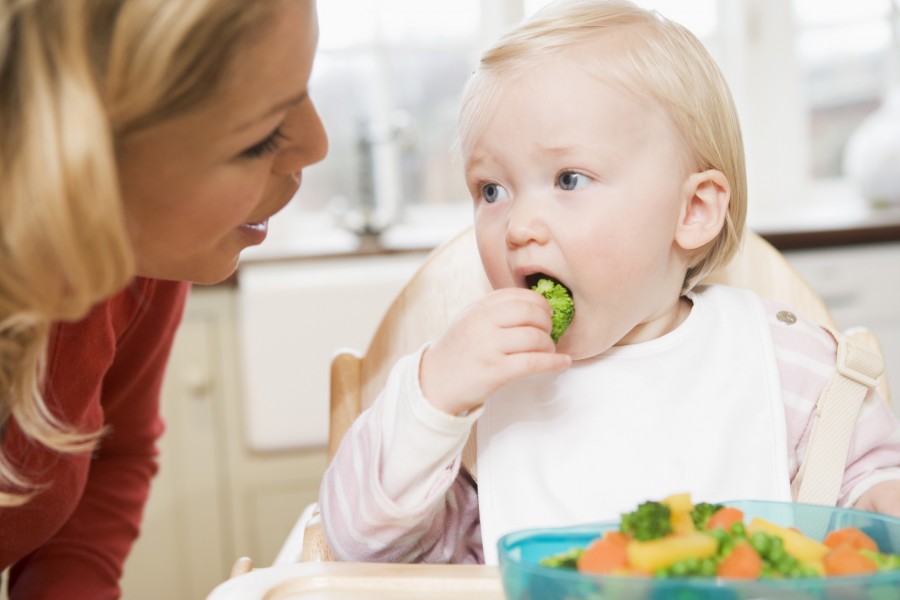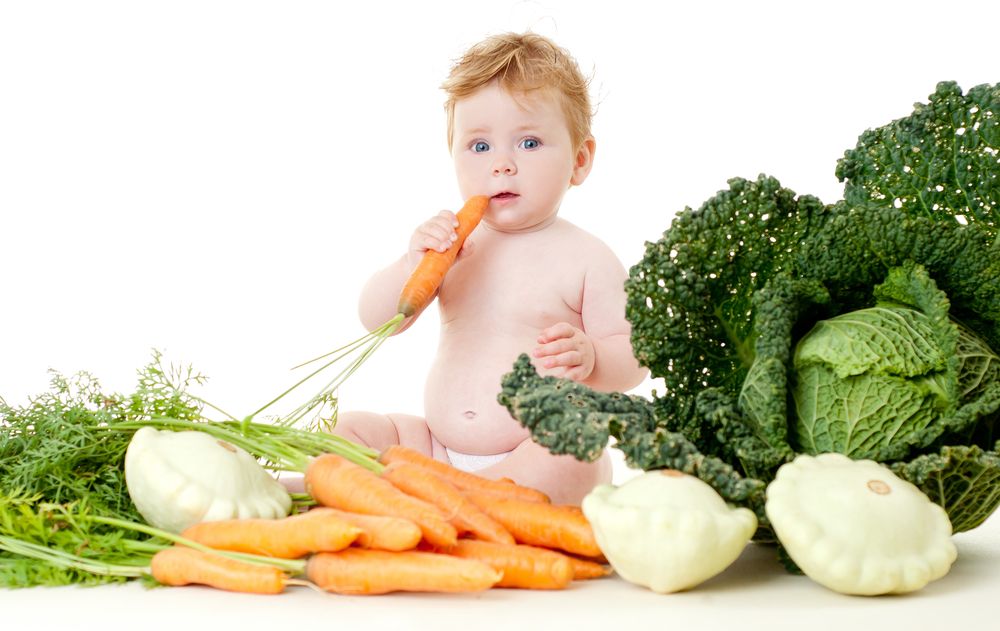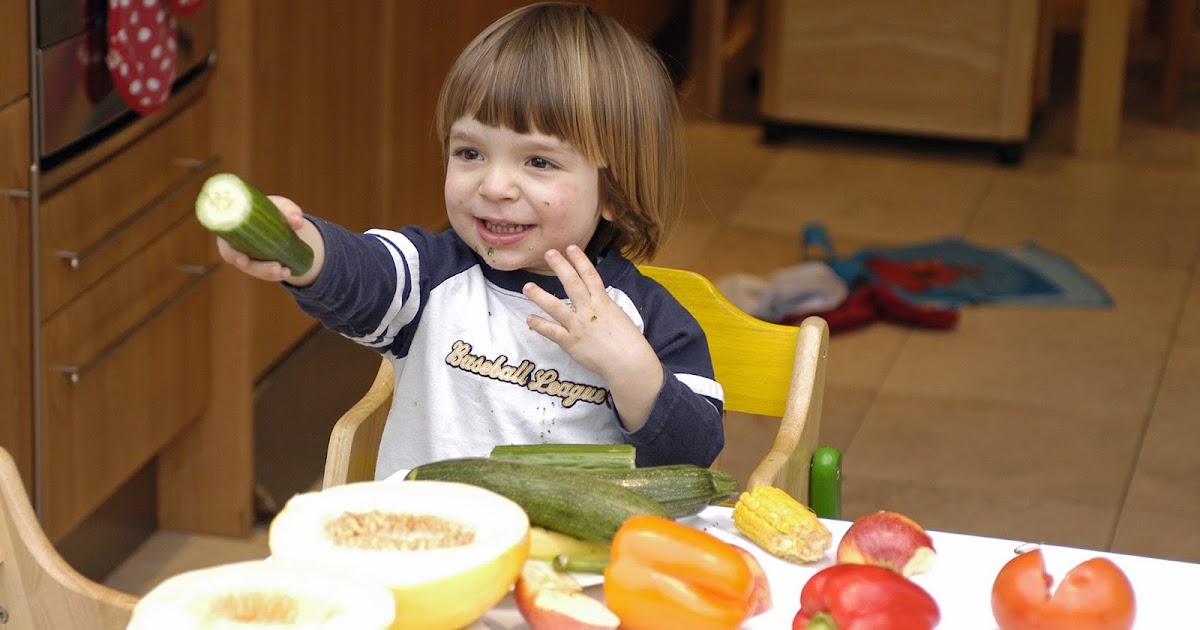Food and babies
When, What, and How to Introduce Solid Foods | Nutrition
For more information about how to know if your baby is ready to starting eating foods, what first foods to offer, and what to expect, watch these videos from 1,000 Days.
The Dietary Guidelines for Americans and the American Academy of Pediatrics recommend children be introduced to foods other than breast milk or infant formula when they are about 6 months old. Introducing foods before 4 months old is not recommended. Every child is different. How do you know if your child is ready for foods other than breast milk or infant formula? You can look for these signs that your child is developmentally ready.
Your child:
- Sits up alone or with support.
- Is able to control head and neck.
- Opens the mouth when food is offered.
- Swallows food rather than pushes it back out onto the chin.
- Brings objects to the mouth.
- Tries to grasp small objects, such as toys or food.
- Transfers food from the front to the back of the tongue to swallow.
What Foods Should I Introduce to My Child First?
The American Academy of Pediatrics says that for most children, you do not need to give foods in a certain order. Your child can begin eating solid foods at about 6 months old. By the time he or she is 7 or 8 months old, your child can eat a variety of foods from different food groups. These foods include infant cereals, meat or other proteins, fruits, vegetables, grains, yogurts and cheeses, and more.
If your child is eating infant cereals, it is important to offer a variety of fortifiedalert icon infant cereals such as oat, barley, and multi-grain instead of only rice cereal. Only providing infant rice cereal is not recommended by the Food and Drug Administration because there is a risk for children to be exposed to arsenic. Visit the U.S. Food & Drug Administrationexternal icon to learn more.
How Should I Introduce My Child to Foods?
Your child needs certain vitamins and minerals to grow healthy and strong.
Now that your child is starting to eat food, be sure to choose foods that give your child all the vitamins and minerals they need.
Click here to learn more about some of these vitamins & minerals.
Let your child try one single-ingredient food at a time at first. This helps you see if your child has any problems with that food, such as food allergies. Wait 3 to 5 days between each new food. Before you know it, your child will be on his or her way to eating and enjoying lots of new foods.
Introduce potentially allergenic foods when other foods are introduced.
Potentially allergenic foods include cow’s milk products, eggs, fish, shellfish, tree nuts, peanuts, wheat, soy, and sesame. Drinking cow’s milk or fortified soy beverages is not recommended until your child is older than 12 months, but other cow’s milk products, such as yogurt, can be introduced before 12 months. If your child has severe eczema and/or egg allergy, talk with your child’s doctor or nurse about when and how to safely introduce foods with peanuts.
How Should I Prepare Food for My Child to Eat?
At first, it’s easier for your child to eat foods that are mashed, pureed, or strained and very smooth in texture. It can take time for your child to adjust to new food textures. Your child might cough, gag, or spit up. As your baby’s oral skills develop, thicker and lumpier foods can be introduced.
Some foods are potential choking hazards, so it is important to feed your child foods that are the right texture for his or her development. To help prevent choking, prepare foods that can be easily dissolved with saliva and do not require chewing. Feed small portions and encourage your baby to eat slowly. Always watch your child while he or she is eating.
Here are some tips for preparing foods:
- Mix cereals and mashed cooked grains with breast milk, formula, or water to make it smooth and easy for your baby to swallow.
- Mash or puree vegetables, fruits and other foods until they are smooth.

- Hard fruits and vegetables, like apples and carrots, usually need to be cooked so they can be easily mashed or pureed.
- Cook food until it is soft enough to easily mash with a fork.
- Remove all fat, skin, and bones from poultry, meat, and fish, before cooking.
- Remove seeds and hard pits from fruit, and then cut the fruit into small pieces.
- Cut soft food into small pieces or thin slices.
- Cut cylindrical foods like hot dogs, sausage and string cheese into short thin strips instead of round pieces that could get stuck in the airway.
- Cut small spherical foods like grapes, cherries, berries and tomatoes into small pieces.
- Cook and finely grind or mash whole-grain kernels of wheat, barley, rice, and other grains.
Learn more about potential choking hazards and how to prevent your child from choking.
Top of Page
Helpful Resources | Nutrition | CDC
If you would like more information on topics related to feeding your baby or toddler, here are some resources:
General
CDC’s Infant and Toddler Nutrition microsite syndication
CDC offers a free Web Content Syndication service that gives public health partners the opportunity to syndicate CDC content directly to their sites without having to monitor or copy updates. To search the CDC infant and toddler nutrition website available for syndication as well as other resources you can share, visit the CDC Public Health Media Library and browse or search for “infant and toddler nutrition”. Learn more about content syndication and how to add CDC syndicated content on your site.
To search the CDC infant and toddler nutrition website available for syndication as well as other resources you can share, visit the CDC Public Health Media Library and browse or search for “infant and toddler nutrition”. Learn more about content syndication and how to add CDC syndicated content on your site.
CDC’s Child and Teen Resources
This collection of resources provides parents and caregivers, health care providers, and partners with tools and information to help children and teens maintain a healthy weight and prevent obesity.
CDC’s Child Development Positive Parenting Tips (Infants)
This CDC website provides information about infants’ development, as well as tips for positive parenting and promoting the safety and health of infants.
CDC’s Learn the Signs. Act Early.
This website includes tools to track children’s milestones and resources about children’s development.
CDC’s Parent Information
This CDC website provides resources and information on pregnancy, infants and toddlers, children, and teens. Learn how to handle common parenting challenges through interactive activities, videos, and more. Healthcare professionals and researchers can also find information on children’s health and safety.
Learn how to handle common parenting challenges through interactive activities, videos, and more. Healthcare professionals and researchers can also find information on children’s health and safety.
CDC’s Division of Oral Health
Tooth decay (cavities) is one of the most common chronic diseases of childhood in the United States. Untreated tooth decay can cause pain and infections that may lead to problems with eating, speaking, playing, and learning. CDC’s Division of Oral Health provides information on what parents and caregivers can do to ensure good oral health for your child.
Dietary Guidelines for Americans 2020–2025 pdf icon[PDF-30.6MB]external icon
These guidelines provide science-based advice for Americans on what to eat and drink to promote health, reduce chronic disease, and meet nutrient needs. The 2020–2025 edition provides recommendations for all life stages, including infants and toddlers.
Feeding Guidelines for Infants and Young Toddlers: A Responsive Parenting Approachexternal icon
This report presents recommendations for promoting healthy nutrition and feeding patterns for infants and toddlers from birth to 24 months, with an emphasis on dietary quality, portion sizes, and mealtime environment.
Healthy Childrenexternal icon
This website was developed by the American Academy of Pediatrics for parents. It features thousands of articles in English and Spanish on children’s health and safety, as well as interactive tools.
United States Department of Agriculture Special Supplemental Nutrition Program for Women, Infants, and Children (WIC)external icon
The WIC Program provides support to low-income pregnant, postpartum, and breastfeeding women, babies, and children up to age 5. WIC provides nutritious foods, information on healthy eating, breastfeeding promotion and support, and referrals to health care.
United States Department of Agriculture Supplemental Nutrition Assistance Program (SNAP)external icon
SNAP provides benefits to low-income individuals and families and provides economic benefits to communities.
Feeding and Beverage Recommendationsexternal icon
Healthy Eating Research, a national program of the Robert Wood Johnson Foundation, offers science-based recommendations for parents and caregivers. Tips are available for feeding children from birth through 24 monthsexternal icon and beverages for children from birth through 5 yearsexternal icon. Tips for older children are also available.
Tips are available for feeding children from birth through 24 monthsexternal icon and beverages for children from birth through 5 yearsexternal icon. Tips for older children are also available.
U.S. Food and Drug Administration (FDA) and Environmental Protection Agency’s (EPA) Advice About Eating Fishexternal icon
The U.S. FDA and EPA provide advice regarding eating fish. This advice can help people make informed choices when it comes to the types of fish that are nutritious and safe to eat. It is especially important for those who might become pregnant, who are pregnant, or who are breastfeeding, as well as for parents and caregivers who are feeding children. This advice supports the recommendations of the Dietary Guidelines for Americans.
Top of Page
Breastfeeding
CDC’s Breastfeeding Information
CDC’s Division of Nutrition, Physical Activity, and Obesity (DNPAO) is committed to increasing breastfeeding rates throughout the United States. CDC provides information for public health professionals and others to help support breastfeeding mothers, such as managing breastfeeding during various maternal and infant illnesses and conditions, any precautions for vaccines during breastfeeding, and recommendations for proper storage and handling of expressed human milk.
CDC provides information for public health professionals and others to help support breastfeeding mothers, such as managing breastfeeding during various maternal and infant illnesses and conditions, any precautions for vaccines during breastfeeding, and recommendations for proper storage and handling of expressed human milk.
International Lactation Consultant Association (ILCA)external icon
ILCA is the member association for professionals who care for breastfeeding families. ILCA’s “Find a Lactation Consultant Directory” can help you find a lactation consultant to get the breastfeeding support you need.
United States Lactation Consultant Association (USLCA)external icon
USLCA is a professional association for International Board Certified Lactation Consultants (IBCLCs) and other health care professionals who care for breastfeeding families. USLCA’s “Find an IBCLC” can help you find a lactation consultant to get the breastfeeding support you need.
WIC, the Special Supplemental Nutrition Program for Women, Infants, and Children—Breastfeeding Support external icon
The United States Department of Agriculture Special Supplemental Nutrition Program for Women, Infants, and Children (WIC) Breastfeeding Support website includes resources for expectant and current mothers about breastfeeding, overcoming common challenges, and thriving to make breastfeeding work for their families.
La Leche League USAexternal icon
La Leche League USA helps mothers to breastfeed through mother-to-mother support, encouragement, information, and education and promotes a better understanding of breastfeeding as an important element in the healthy development of the baby and mother.
Office on Women’s Healthexternal icon
The Office on Women’s Health’s vision is for all women and girls to achieve the best possible health outcomes. They provide information on breastfeeding to help women make infant feeding decisions and to guide mothers through the breastfeeding process.
Top of Page
Infant Formula
Questions & Answers for Consumers Concerning Infant Formulaexternal icon
The U.S. Food & Drug Administration regulates infant formula and has a list of questions and answers about infant formula.
Infant Formula Do’s and Don’tsexternal icon
The U.S. Food and Drug Administration provides information on infant formula preparation and storage, as well as other tips on how to keep infant formula safe.
Top of Page
Food Safety
Food Safety Concerns for Children Under Fiveexternal icon
Food safety is particularly important for young children. Foodsafety.gov provides information on safely preparing food for your child.
Top of Page
Meal Time
Fruits & Veggies—Have a Plant Movementexternal icon
A resource designed to help spread the word about the health benefits of adding more fruits and veggies to your diet.
USDA MyPlate Kitchenexternal icon
This online tool features a large collection of recipes and resources to support building healthy and budget-friendly meals. Site features include:
- Extensive search filters on cuisine, cooking equipment, nutrition content, and more.
- Detailed nutrition information.
- Cookbooks to browse and download or build your own.
- Recipe star ratings, review comments, and sharing on social networks.
Video Series on How to Introduce Solid Foods
1,000 Days has developed helpful videos about introducing solid foods to your baby. Topics include:
Topics include:
- Is your baby ready to start eating foods?
- What is a good first food for your baby?
- What to expect when introducing first foods
- How much should I feed my baby?
- How to win at mealtimeexternal icon
- What foods should my baby avoid?
- What should your baby eat in the first year?
Top of Page
Vitamins and Minerals
Vitamin and Mineral Fact Sheetsexternal icon
The National Institutes of Health’s Office of Dietary Supplements has fact sheets for consumers and health professionals about vitamins, minerals, and dietary supplements.
Top of Page
Children and food: to eat or not to eat?
Everyone knows that the number one concern of any Jewish mother is to feed her child. And not just feed, but so that the child crawls out from the table on his haunches - happy and well-fed. However, is this correct, and what to do if the child (oh, horror!) Refuses to eat, we are discussing today.
The question of feeding arises before parents literally from birth. First, a decision is made whether to breastfeed or transfer the child to artificial feeding, then the problem arises of choosing the time and method of feeding: by the hour or on demand, supplement or let him eat as much as he can eat. All this is solved in each family in different ways, depending on the situation.
When the child has already grown up and eats the same food as the parents, the difficulties do not recede, again it is necessary to decide the issue of diet, what can and cannot be given to the child, and so on. And how often do you have to listen to parents talking about the fact that the child does not eat well or slowly, or only cookies, and so on. Here are some rules and tips that will help you feel calmer in this matter, and as a result, the child will eat better.
And I’ll make a reservation right away, all these recommendations apply to healthy children, if the child has any serious illnesses, allergies or something else that affects how he eats, then you need to consult with the relevant specialists: doctors, nutritionists, psychologists, etc.
First, it is important to understand that nutrition is one of the basic needs of the body, so normally, a child who is not denied food will not starve to death, even if he refuses to eat for a while. Over time, young mothers are able to distinguish crying in their children, which relates to hunger, from all other types of crying. Accordingly, it is recommended to feed the child exactly when he is hungry, this will help him learn to determine for himself that he is hungry, and also to feel the moment of saturation. To do this, it is important to feed the baby not by the hour, but when he wants to. Here it is important to distinguish between the moments when the child is really hungry, and when he just wants contact and communication through feeding. It happens that children want to eat, but they eat little, it happens that they indulge. Understanding comes with experience, the main thing to remember is that food is pleasure, you should not make violence out of feeding.
When the child has grown up and already eats with his parents, it is important to feed him according to the schedule: breakfast, lunch and dinner, and ideally they should take place every day at the same time. In addition to the fact that the body gets used to the schedule, this order of things creates in the child a sense of predictability and clarity of the outside world, which is necessary for his harmonious psychological development. Trust your child and his appetite, offer food, but do not force him to eat. This will create an atmosphere of respect and trust.
In addition to the fact that the body gets used to the schedule, this order of things creates in the child a sense of predictability and clarity of the outside world, which is necessary for his harmonious psychological development. Trust your child and his appetite, offer food, but do not force him to eat. This will create an atmosphere of respect and trust.
Snacks are allowed, but should not be cookies or sweets, but an apple, carrot, cucumber, or any other fruit or vegetable. If the child does not want to eat at a time when everyone is eating, do not force him, do not frighten him, do not punish and do not turn feeding into a game and theater, trying to feed your child. Calmly warn the baby that you will have to wait until the next meal, and of course do not give him any cookies and buns during the break. There will be nothing terrible about skipping feeding, but the child will gain the experience of responsibility for his decisions.
It is also important to say about what to feed the child. Decisions about what will be for breakfast, lunch or dinner, are made by the parent. He can consult with the child, but the final decision and responsibility is always with the adult. Starting to cook food, you can offer your child a choice, but not open (what would you like for lunch?), But from what you think is right and from what is now available and convenient to cook (what will you eat for breakfast: cottage cheese Or an egg?). This again will give the child a sense of independence, he will understand that he is considered, but at the same time he will be able to choose something useful, and not chips or sweets.
Decisions about what will be for breakfast, lunch or dinner, are made by the parent. He can consult with the child, but the final decision and responsibility is always with the adult. Starting to cook food, you can offer your child a choice, but not open (what would you like for lunch?), But from what you think is right and from what is now available and convenient to cook (what will you eat for breakfast: cottage cheese Or an egg?). This again will give the child a sense of independence, he will understand that he is considered, but at the same time he will be able to choose something useful, and not chips or sweets.
As a final tip, try not to console your child with food. When he is upset, he wants to comfort him with a candy or offer to go to his favorite cafe or buy ice cream. But this seemingly innocuous way to distract the baby from his grief, in the future, can lead to the formation of a clear connection between food and comfort. Then the already grown child will continue to eat his difficulties, as this has always been the easiest and most enjoyable way to cope with them. There are two dangers here: the difficulty does not go away, no matter how tasty we eat, and if we eat too much, very soon there will be problems with being overweight.
There are two dangers here: the difficulty does not go away, no matter how tasty we eat, and if we eat too much, very soon there will be problems with being overweight.
Source: mjcc.ru
Join in Telegram
Subscribe and we will send you the most interesting articles every week!
Eat, it's healthy! How to teach a child a healthy relationship with food?
Does the child eat a limited set of foods and flatly refuse to try new things? Or, on the contrary, does he overeat, but his food is mostly sweet and fast food? What a healthy attitude to food looks like in a family, why you can’t force a child to eat, and sweets shouldn’t be a reward, says psychologist Anna Skavitina.
Anna Skavitina, psychologist, analyst, member of the IAAP (International Association of Analytical Psychology), supervisor of the ROAP and the Jung Institute (Zurich), expert of the Psychology journal
What is a healthy diet?
There are two serious issues that parents regularly turn to me for help with. What to do when my child eats very little, and only certain foods - I'm just afraid of not feeding him, and my child eats a lot, I'm afraid that his health will suffer from overeating.
What to do when my child eats very little, and only certain foods - I'm just afraid of not feeding him, and my child eats a lot, I'm afraid that his health will suffer from overeating.
Of course, each situation and each child is unique, but there are a few general points worth discussing. These two questions are asked by parents who have the opportunity to feed their child enough, and ideas about what healthy eating is. Statistics show that 90% of children in developing countries still do not have such a choice, and their parents are concerned about simply feeding the child. Malnutrition is a serious problem that starts at an early age. Low birth weight occurs in approximately 25% of children in some countries in Asia and Africa. It causes the death of almost 10 million children every year. More than 200 million children under the age of 5 in developing countries do not develop fully, mainly due to chronic malnutrition. The parents of these children do not think about the usefulness of nutrition, their children usually do not suffer from selectivity in food, and few people think about food allergies when deciding questions of survival.
Our children in developed countries are the first or second generation of people who do not starve and have a fairly large food choice. Therefore, it is not at all surprising that people who have survived with a shortage of food, and have always been looking for ways to get food to feed their children, will not have adequate skills to cope with a situation where food is now always in abundance. Rather, they will either suffer that they cannot feed their children in any way (just like their mothers, grandmothers and great-grandmothers during times of famine), or worry that children eat too much - compared to mothers, grandmothers and great-grandmothers in their childhood. That is why the skills of parents regarding the nutrition of children often have to be artificially regulated, coping with off-scale anxiety and not hoping that in parents these skills are automatically activated immediately upon the birth of a child.
How do I deal with anxiety?
Parental anxiety related to overeating/overeating children usually leads to compulsive eating. “Be sure to eat THIS (meat, fish, vegetables, fruits)” or “Never eat THIS (fast food, sweets, sodas”, “You can’t leave anything on your plate, if you don’t eat, you won’t get out”, “Put the second piece of pie back.” Bottom line: parents' anxiety, inherited as a baton from their ancestors, is transmitted to children and colors their relationship with food with intense anxiety and guilt. When you worry, you do not hear your body signals well and either overeat or undereat. Thus, a vicious circle is formed that , of course, does not contribute to a healthy diet.
“Be sure to eat THIS (meat, fish, vegetables, fruits)” or “Never eat THIS (fast food, sweets, sodas”, “You can’t leave anything on your plate, if you don’t eat, you won’t get out”, “Put the second piece of pie back.” Bottom line: parents' anxiety, inherited as a baton from their ancestors, is transmitted to children and colors their relationship with food with intense anxiety and guilt. When you worry, you do not hear your body signals well and either overeat or undereat. Thus, a vicious circle is formed that , of course, does not contribute to a healthy diet.
So, the first rule of normalization of relations with food in the family: no coercion of children.
It is very difficult for many parents to fulfill because it is scary to trust their children and the idea that their bodies know how much food they need.
Our children are lucky: there is really a lot of food around, their chance of starving to death is minimal if they can reach the fridge. If food is available and children are not forcibly restricted, after a while they will adjust the amount necessary for their normal development. If you're really, really scared and you don't believe the situation will change, or you're worried that when it does, "it might be too late," start keeping your child's food diary to record everything he actually ate during the day.
If food is available and children are not forcibly restricted, after a while they will adjust the amount necessary for their normal development. If you're really, really scared and you don't believe the situation will change, or you're worried that when it does, "it might be too late," start keeping your child's food diary to record everything he actually ate during the day.
It is better to keep a diary for at least one or two weeks, because children eat unevenly, just like adults. Today they want and eat more, tomorrow - less. You will be surprised, but little ones actually eat not so little, and those who overeat not so much.
If anxiety does not leave you, go with a food diary to a pediatrician or a nutritionist, let him assess the nutritional value of the child and help you create a varied menu if there are really difficulties with nutrition.
Rule #2: organize the conditions for a healthy diet in the family. Let the child have the opportunity to eat what he needs for development. Your task is to ensure the purchase and preparation of tasty and healthy food. Yes, healthy food must be delicious! For some reason, few people like unleavened rice and meat without salt and sauces. Unpalatable food can easily turn into compulsion (see rule 1). One of the reasons for overeating is the belief that healthy food always tastes bad and unhealthy food always tastes good. What to do if the child does not like the taste of vegetables or fruits, meat or fish? Suggest other options or forms. It is normal if the child does not eat fruits, but eats vegetables, or vice versa, does not eat boiled, but eats raw, does not eat any yet, but is ready for mashed potatoes in jars or fresh juices. He does not eat meat - we offer vegetable protein: beans, lentils. Your task is to provide the child with the necessary chemicals in the form that the child will like now. If your child is very selective in nutrition, then there is good news - he definitely has enough food. There is also bad news: if a child prefers to eat only sweets, he .
Your task is to ensure the purchase and preparation of tasty and healthy food. Yes, healthy food must be delicious! For some reason, few people like unleavened rice and meat without salt and sauces. Unpalatable food can easily turn into compulsion (see rule 1). One of the reasons for overeating is the belief that healthy food always tastes bad and unhealthy food always tastes good. What to do if the child does not like the taste of vegetables or fruits, meat or fish? Suggest other options or forms. It is normal if the child does not eat fruits, but eats vegetables, or vice versa, does not eat boiled, but eats raw, does not eat any yet, but is ready for mashed potatoes in jars or fresh juices. He does not eat meat - we offer vegetable protein: beans, lentils. Your task is to provide the child with the necessary chemicals in the form that the child will like now. If your child is very selective in nutrition, then there is good news - he definitely has enough food. There is also bad news: if a child prefers to eat only sweets, he . .. is malnourished and tries to “grab” fast carbohydrates for life instead of those substances that his body really needs.
.. is malnourished and tries to “grab” fast carbohydrates for life instead of those substances that his body really needs.
Rule No. 3 : Do not rigidly divide food into permitted and prohibited. Forbidden fruit is known to be sweeter. Children will find an opportunity to get themselves a “forbidden thing” bypassing their parents: stealing from kitchen cabinets with holiday stash, from the refrigerator, buying sweets and fast food with all their pocket money, friends, grandparents, in the end. We organize the possibility of a normal full-fledged diet, and show how to deal with not very healthy food. The problem is not the food itself, the problem is that you should not eat only such food, or eat too much of it. We understand that there will be no drama if the child eats normal food and eats some sweets for dessert: a cake, 2-3 sweets or fruit. There will be no drama if sometimes you eat fast food along the way if you are hungry.
Rule #4 : Family breakfasts, lunches, or dinners at a well-laid table help to pass on good eating habits to children and good family relationships. Family meals become a place where you can provide "pedagogical complementary foods" - try food from your parents' plate and thereby expand your understanding of various foods and their forms, expand your food repertoire. Personal example is contagious. It is important not to panic and not tear out of the hands of the child what he decides to try, even if it seems to you that this is not the most useful or the child will not be able to cope with it due to age. Allow me to experiment with food! If you don't like it or can't chew it - it's okay, it will spit it out. If a child has tried food and has a slight reddening, this does not mean that the child is allergic to it, and now you should never give this product for anything and ever. Let's take a little at a time to let the child's body adjust. You can start eating together from the moment when the child already receives the first complementary foods and can sit for some time, that is, from about 6 months. It is better to agree that the family eats without gadgets in their hands.
Family meals become a place where you can provide "pedagogical complementary foods" - try food from your parents' plate and thereby expand your understanding of various foods and their forms, expand your food repertoire. Personal example is contagious. It is important not to panic and not tear out of the hands of the child what he decides to try, even if it seems to you that this is not the most useful or the child will not be able to cope with it due to age. Allow me to experiment with food! If you don't like it or can't chew it - it's okay, it will spit it out. If a child has tried food and has a slight reddening, this does not mean that the child is allergic to it, and now you should never give this product for anything and ever. Let's take a little at a time to let the child's body adjust. You can start eating together from the moment when the child already receives the first complementary foods and can sit for some time, that is, from about 6 months. It is better to agree that the family eats without gadgets in their hands. Firstly, they interfere with communication, and secondly, they do not allow you to feel the signals of your body and stop in time when you are full.
Firstly, they interfere with communication, and secondly, they do not allow you to feel the signals of your body and stop in time when you are full.
Rule #5: Take your child to shops and markets when you plan to shop for groceries. Show and tell what you buy and why, what criteria you are guided by so that the family has good nutrition. Offer your child to help put food in the cart, choose vegetables and fruits himself, ask what he would like to try and cook. Cook together, showing and telling why we cook food this way. Let me cook for myself, even if later it will take a long time to clean the kitchen - he won’t try, he won’t learn.
Food is neither a reward nor a punishment. “Do your homework - you will get a lollipop”, “Eat soup - you will get a cake” and similar phrases quickly convey to children that lessons and soup are obviously disgusting, and lollipop and cake are something to strive for. Food is needed to have a healthy body, to have enough strength to run, jump and talk, to enjoy food and rejoice that we were lucky to be born in a place and at a time in which our children and we no longer starve .











